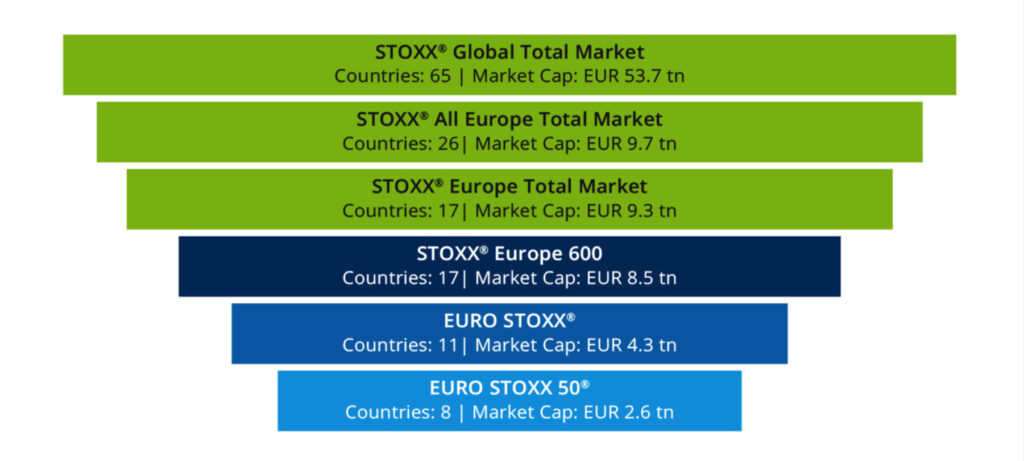STOXX is synonymous with equity indexing in Europe. The STOXX® Europe 600 Index, EURO STOXX® Index and EURO STOXX 50® Index have for over 20 years provided liquid and effective access to the region’s stock market, based on transparent rules and an objective methodology.
A new Qontigo paper1 from Ladi Williams, Product Manager at STOXX, and Anand Venkataraman, Head of Product Management, reviews the profile and characteristics of these three benchmarks and the range of investment vehicles available to access them.
Chart 1 shows the build-up of the three STOXX European benchmarks. The STOXX Europe 600 Index is a broad but tradable benchmark for the entire developed regional market, whose comprehensive coverage offers diversified country and industry allocation. The EURO STOXX index is its euro-denominated subset and represents nearly 93% of the Eurozone’s free-float market capitalization, covering large-, mid- and small-cap stocks.
The iconic EURO STOXX 50 index, in turn, is a blue-chip benchmark that provides diversified access to the Eurozone’s largest supersector leaders.
Chart 1

All three indices track stocks with a minimum daily trading turnover. They also offer well-diversified industry exposure compared to other regions of the world, the study shows.
A guide for overseas investors
STOXX’s European benchmarks have established a leading position for themselves in the marketplace since 1998 and are an essential tool for local investors. On the other hand, many overseas asset owners continue to expand their portfolios to foreign markets, and this guide may be particularly helpful for them. According to one study, the average weight of domestic equities holdings in the pensions industry of 22 countries fell to 40% in 2018 from 69% in 1998.2
A menu of investment products
Foreign investors will also be able to find information in the paper about the indices’ country and industry exposure, liquidity and tradability, as well as analysis like valuation, dividend yield and performance.
STOXX indices underlie highly accessible alternatives to allocate capital into European equity markets. According to the STOXX study, there are over 63 billion euros invested in exchange-traded funds (ETFs) tracking the three STOXX European benchmarks and their sector and style variants. Separately, futures and options on the EURO STOXX 50 index traded on Eurex are among the most liquid derivatives contracts in Europe and the world.
Vehicles for sustainable strategies
This year saw the launch of versions of the STOXX Europe 600 and EURO STOXX 50 that meet environmental, social and governance (ESG) principles. Both ETFs and derivatives contracts now track those indices, which include the STOXX® Europe 600 ESG-X Index and EURO STOXX 50® ESG Index. They address the increasing demand for sustainable index concepts and help solve the problem of tracking error that arises when using traditional market-capitalization-weighted benchmarks in responsible portfolios.
Get a closer look
This latest research study from STOXX is intended as a comprehensive guide to three of Europe’s most popular equity indices, particularly for non-domestic investors looking to reduce home bias and diversify their portfolios. We invite you to download the publication and get a closer look into STOXX’s European benchmarks.
Featured indices
1 Williams, L., Venkataraman, A., STOXX, ‘STOXX European Flagship Indices for Overseas Investors,’ Nov. 2019.
2 Willis Towers Watson, Thinking Ahead Institute, Global Pension Assets Study 2019.
